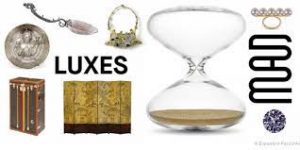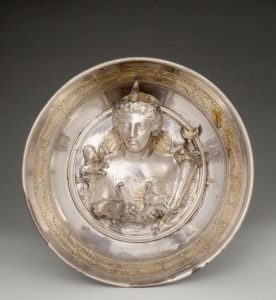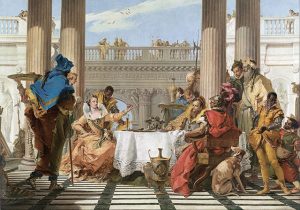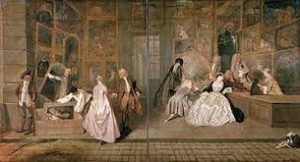What is Luxury? ‘Luxes’ MAD-Paris.
Dr. Beverly Held, aka ‘Dr. B.’

Figure 1. Luxes Exhibition Poster. MAD-Paris.
I went to see an exhibition a few days ago at MAD-Paris, which is how I am feeling, now that all the museums in France have been closed, again, along with the theaters and symphony halls, to say nothing of the bistros, cafes, bars, restaurants, in short what makes life worth living, at least for me here in Paris, separated as I am from my kids in San Francisco. Well, anyhow, as I was saying, I went to the Musée des Arts Decoratifs on Tuesday. To save you any embarrassment, I pass along, as a public service announcement, the following: the Musee des Arts Decoratifs is now MAD-Paris (which, as I say is how I feel, now). And while I am at it, I remind you that the Musee d’Orsay is now M’O (pronounced MO, the ' does not change the pronunciation). It is a branding thing, which turns out to be related to today’s topic - trust me & keep reading.
Anyhow, it is a good thing I went on Tuesday because until further notice, I won’t be going there, or anywhere else interesting, unless Picard is your thing (I’m talking to you Terrance), for at least a month. The exhibition I saw had just opened (and now has just closed), Luxes, described as the history of luxury in 100 or so objects.
I immediately thought about the 2010 BBC radio series, written and presented by the then Director of the British Museum, called The History of the World in 100 Objects. (Figure 2) I was homeschooling my son at the time and the series and book made teaching world history a pleasure since each object was a window into a different time, place, culture, religion. It was thorough, it was rigorous, it was wonderful. The idea was to travel back in time and across the globe over two million years to see how humans ‘have shaped our world and been shaped by it’. The story was told ‘exclusively through the things that humans have made: from a ‘Stone Age tool to a credit card.’ Telling history this way ‘is what museums are for,’ Of course, this was “ ‘an’ history of the world, not ‘the’ history.”

Figure 2. Some of the objects in The History of the World in 100 Objects, BM, 2010
So, I was interested to see not only the objects in this exhibition but the intellectual underpinning for it, why certain objects were selected and what they tells us about us. The exhibition currently at MAD-Paris is a version of one that just closed at the Louvre Abu Dhabi (Figure 3) entitled, ‘Ten thousand years of luxury,’ which sounds a lot more doable than the 2 million years the British Museum tackled. In addition to which, the director of the British Museum did it with 100 objects while the Louvre’s exhibition included 350. Olivier Gabet, director of MAD-Paris and curator of the exhibition, explained why an exhibition on luxury, “Never in the history of mankind has the word 'luxury' been used so frequently as in these first decades of the 21st century.” And why the Louvre-Abu Dhabi? Because, “(the) concept (of luxury) evolves within a melting pot of complex influences (and) the very identity of Louvre Abu Dhabi,…shaped by the dialogue between civilizations, is an invitation to embrace the thousand and one facets of luxury from the most ancient times to its most current manifestations.”

Figure 3. Louvre-Abu Dhabi, Jean Nouvel architect, 2017
The exhibition in Abu Dhabi set out to trace how the definition of luxury has evolved over time and to establish the factors that go into making an object precious, like its age, its symbolic value, the quality of the craftsmanship and/or the scarcity of the raw material/s used in its manufacture. The exhibition was also an investigation into the role luxury has played at different times and in different places.
The exhibition at MAD-Paris is pared down, less luxurious if you will with 100 objects rather than 350. Among the oldest pieces in both exhibitions are two cups from the Louvre (Paris), which are part of the Boscoreale treasure, (Figure 4) buried by their owner in a wine tank during the eruption of Mt. Vesuvius in 79 C.E. and unearthed in 1895. “The decoration on these two cups represent an invitation to enjoy the present,” to “enjoy life while you can, for tomorrow is uncertain.” An exhortation to ‘party on,’ certainly more agreeable than the Renaissance momento mori above the skeleton in the painting by Masaccio I showed you last week which read, “I once was what you are and what I am you also will be.” (Figure 5) I sure hope the owner of the two cups got to enjoy a few drinks before disaster destroyed life as s/he knew it. And now that uncertainty is upon us, I am wishing that I had partied a little harder back in the day.

Figure 4. Cup, Boscoreale treasure, 79 C.E

The oldest object in both exhibitions is the Abu Dhabi Pearl, (Figure 6) so named because it was discovered on an island off Abu Dhabi, in 2017. Radiocarbon dated to between 5800 and 5600 BCE, it is the world's oldest natural pearl, so the earliest evidence for pearling found anywhere in the world. Pearls were likely used then as they are now - as adornment - but also for trading before money got in the way.

When I saw the pearl, I thought about Cleopatra’s famous banquet for Marc Antony in about 30 B.C.E., (Figure 7) as described by Pliny the Elder’s Natural History written 150 years later. Cleopatra had promised Marc Antony the most sumptuous feast imaginable. Marc Antony was unimpressed.Then things got interesting. Cleopatra was wearing, according to Pliny, enormous pearl earrings. She ordered her servant to bring her a bowl of vinegar. She took one pearl, dropped it into the vinegar (or she may have had it ground up first, reports vary), and swallowed it. She offered Marc Antony the other pearl, he declined. For swallowing the pearl, Cleopatra was depicted in medieval times as Luxuria, the epitome of extravagant lust. If Cleopatra had the pearl crushed before she drank it, then that was that and it was indeed a very expensive dessert. If she swallowed it whole, maybe she found it (or more likely her servants found it) after coffee the next morning !

Figure 7. Banquet of Cleopatra, Giovanni Battista Tiepolo, 1740
That second scenario reminds me of a trick the rich banker Agostino Chigi played on his dinner guests at the Villa Farnesina in Rome (Have you been? If not, I mean, if not yet, you must go as soon as you can escape from wherever you are being held). The banker gave a dinner on the loggia of his villa, which projected out over the Tiber River. After each course, servants threw the silver plates into the river, to assure Chigi’s guests that the plates were only used once (very hygienic). After Chigi’s guests departed, his servants recuperated the silver from the nets below the loggia that had been there the entire time.
Cleopatra, maybe; Agostino Chigi, definitely, dealt with excessive displays of opulence by pretending to destroy the costly items. That they were not destroyed is, I guess, a sign of sanity or frugality but definitely a way to have it both ways, if you will. Sumptuary laws (restricting luxury and extravagance) were introduced into Europe in the late 12th century. In 15th C Florence, a city famed for its courtly culture, restrictions on wardrobe sizes, colors and accoutrements, were more impetus than deterrent for finding ways to celebrate luxes and conspicuous consumption. Take for example, the beautiful fresco by Benozzo Gozzoli, commissioned by Cosimo I for a private family chapel at the Palazzo Medici (Figure 8) in Florence. The lavishly painted scene is ostensibly the biblical Journey of the Magi, but it actually portrays the Medici clan and their friends reenacting the scene, as wealthy Florentines had done annually on January 6 since at least 1390. Cosimo de Medici rides on a donkey (what a noble act of humiliation). Lorenzo the Magnificent sits astride a gallant white horse. Along with family portraits are symbols and emblems of the Medici, like the Medici coat of arms decorating the horses’ harnesses. I read somewhere that this annual re-enactment of the Procession of the Magi permitted the Medici and others to have marvelous clothes made for them. And by donating their luxurious costumes to the poor after the procession, they could have new ones made for the following year. Again, a double win - new clothes and acts of charity. (Figure 9)

Figure 8. Journey of the Magi, Benozzo Gozzoli, 1460. Palazzo Medici-Riccardi, Florence

Figure 9. Detail of above, Lorenzo Medici
Sumptuary laws were alive and well in Puritan Boston from the moment that sect arrived in the New World. And one would think that such laws would be taken seriously by such a serious bunch. How delightful it is then to read the diarist Samuel Sewell’s accounts of funerals for which he served as pall bearer. For the funeral of one of the Winthrop clan in 1717, Sewell and at least 200 others received gloves, scarves, (and) rings from the family. Sure he ‘went home with a prayer on his lips’ but he also had a ’ring on his finger, gloves on his hands, and yards of material over his shoulders.’ Sewell’s ‘take’ sounds a lot like the swag bags actresses get at Oscar parties.
The 16th and 17th centuries are celebrated in the exhibition as the Age of Exploration, when European kings and princes sent explorers out to find new lands to claim, natural riches to exploit and new peoples to conquer. The period is documented by a variety of objects from scientific instruments (Figure 10) and stuffed animals to tapestries and paintings. The scientific instruments were essential to undertake the voyages and the ‘loot’ the explorers brought back, justified their cost.

Figure 10. Compass
And where, you ask, did the kings and princes keep all this stuff, alive and dead, stuffed or otherwise. Well, in their wanderkammern, kunstkammern and menageries, of course. A painting of a wanderkammer is in this exhibition. Princes and kings competed with each other to amass the most exotic menageries or zoos but as often as not, they traded too, a turkey from America for a Rhinoceros horn from Africa, for example.
Perhaps you remember the book I reviewed a few months ago, on the artist Brueghel? In it is a passage written by the German artist Albrecht Dürer, in 1520, when he saw objects that had been brought back to Europe from the New World. Durer wrote. “I have seen nothing which has gladdened my heart so much as these things. For I have seen therein the wonders of art and have marveled at the subtle ingenuity of people in distant lands.” Durer was inspired by what fellow artists had created. Kings and princes were encouraged to continue seeking new lands and new sources of revenue - silver from Mt Potosi in Bolivia, human labor from Africa, etc.
The 18th century is celebrated here by the marchand-merciers who Diderot dismissively described in his Encyclopedia as “Merchants of everything and doers of nothing” . But Diderot was wrong, they played a major role in the development of the luxury industry in France during the 18th century. There was a fabulous exhibition of marchand-merciers at the Musee Cognacq-Jay two years ago.(Figure 11) I learned at that exhibition, that the marchand-merciers were traders, importers, collectors, designers and decorators. And that only a marchand-merciers who worked outside the guild system had the right to mix and match furniture and objects, as for example, mounting Chinese porcelains with gilt-bronze handles and stands; fitting cabinetmaker’s furniture with Japanese lacquer or Sevres porcelain plaques, etc. (Figure 12, Figure 13)

Figure 11. La Fabrique du Luxe, Exhibition poster, Musee Cognacq-Jay 2018

Figure 12. Flowers with cage, both Luxes and La Fabrique du Luxe exhibitions

Figure 13. From Cognacq-Jay exhibition, mixing materials and genres, only allowed them
The exhibition at the Abu-Dhabi Louvre exhibition included a marchand-merciers shop. The closest we can come to that is one of my favorite paintings by one of my favorite artists, Jean-Antoine Watteau, called L'Enseigne de Gersaint (Figure 14), painted in 1721 for the marchand-mercier, Edme Francois Gersaint. The painting makes Gersaint’s tiny boutique, more a booth really, seem large enough for quite a few people to mill about and lounge around as they are shown Gersaint’s stock. The largest part of the exhibition at MAD-Paris is dedicated to the period since the Industrial Revolution, since the 1850s, when the means of production of luxury items changed and consumption did too. We learn about the importance of the various world fares for the dissemination of luxury items. Fashion as we understand it today, in women’s haute couture, takes center stage in the exhibition, moving from the mid-19th century British fashion designer Charles Frederick Worth, the “father of haute couture” (Figure 15) to Coco Chanel’s “little black dress” (Figure 16) and ready-to-wear ensembles from that fashion house and those of Hèrmes, Christian Dior and Louis Vuitton.

Figure 14. L’Enseigne de Gersaint, Jean-Antoine Watteau, 1721

Figure 15. Dress by Charles FrederickWorth

Figure 16. Gabriele ‘Coco’ Chanel, Little Black Dress
I couldn’t help but wonder why the fashion houses of Yves St. Laurent, Lanvin and Chloé, for example, aren’t represented in the exhibition. I get the sense somehow that we are talking about paid product placement. Because, as I was wandering through the Renaissance section, I saw a pair of Louboutin heels. Did he pay to be included?
Jewelry is here too, of course, from Van Cleef & Arpels and Cartier to Tiffany & Co. represented by a photo of a vignette that Robert Rauschenberg and Jasper Johns created for Tiffany’s NYC flagship store window. (Figure 17) It shows a diamond bracelet lying precariously close to the edge of a scruffy wooden dock. Quel juxtaposition! I remember going to this Tiffany & Co. store a few years ago. There were as many ‘greeters’ as sales people. There was a line of people waiting in front of the new restaurant to eat, as Audrey Hepburn had done, Breakfast at Tiffany’s. And there was so much stuff for sale. Sure, there was gold and silver and diamonds and pearls. But if you tried hard enough, you could probably find something you could afford. And what could be better than to be clutching an eggshell blue Tiffany bag when you left.

Figure 17. Tiffany & Co window display, NYC, Rauschenberg & Johns, 1956
Is this a democratization of haute couture or is it a depreciation of it? And what happened to luxury ? Giorgio Armani has as many price points as the Gap. And if you like Porsches but can’t afford one, well you can buy a cap or a key chain or a tee shirt with the Porsche logo. I think this all started with Louis Vuitton luggage.(Figure 18) A few years ago there was a Vuitton exhibition at MAD-Paris in which they traced the use of the Louis Vuitton logo on luggage. It was the moment when there was more caché in having the manufacturer’s initials than your own on your own bespoke luggage that started this.

Figure 18. Louis Vuitton luggage, MAD-Paris exhibition
The exhibition ends by considering the place of luxury in contemporary society, with issues like globalization, sustainability and mass consumption. It may have started with fast food but we have definitely arrived at fast fashion, and fast travel too. This section pushes the definition of luxury to include what cannot be bought (I’m not convinced) like time, space and freedom of movement. I have had a feeling for a very long time that the people who don’t believe in climate change, DO believe in climate change, they are just convinced that they are going to find a place (bubble, maybe?) for themselves and their families that is clean and safe while they continue to destroy the planet and reap money from selling pollutants to the rest of us. What a luxury.
The postscript to the exhibition is surely the question of what luxury is now, in the time of pandemic. Is it the wherewithal to flee Paris for your country home or is it the luxury to use the time you unexpectedly have, to determine how you will define luxury in your future. Some (slow) food for thought.
